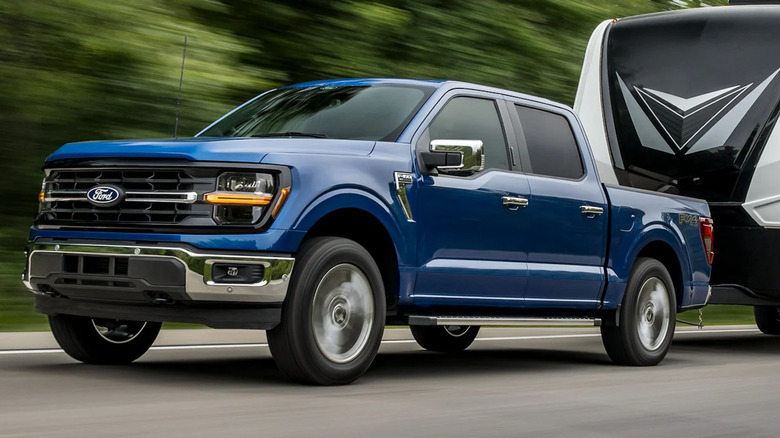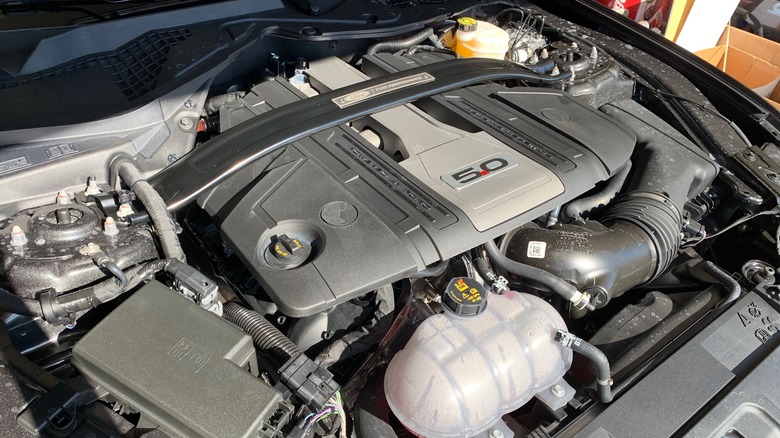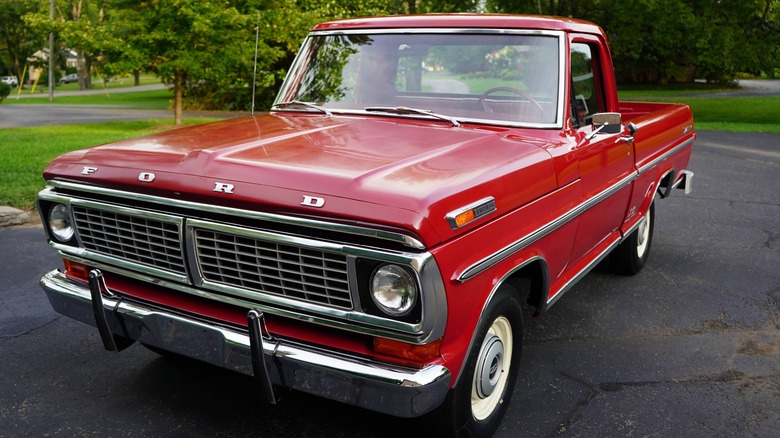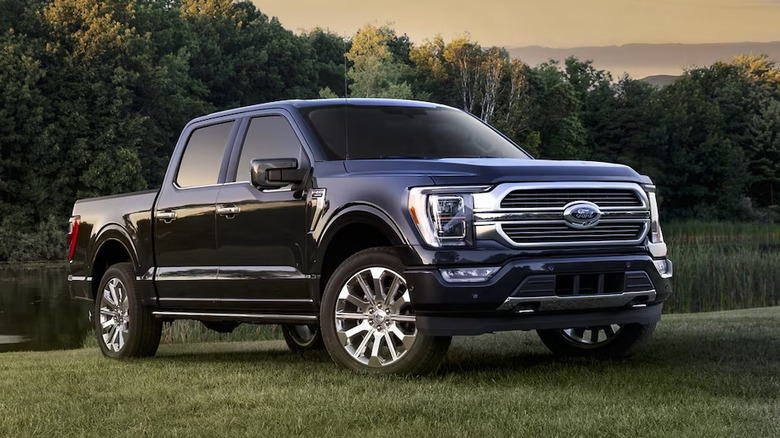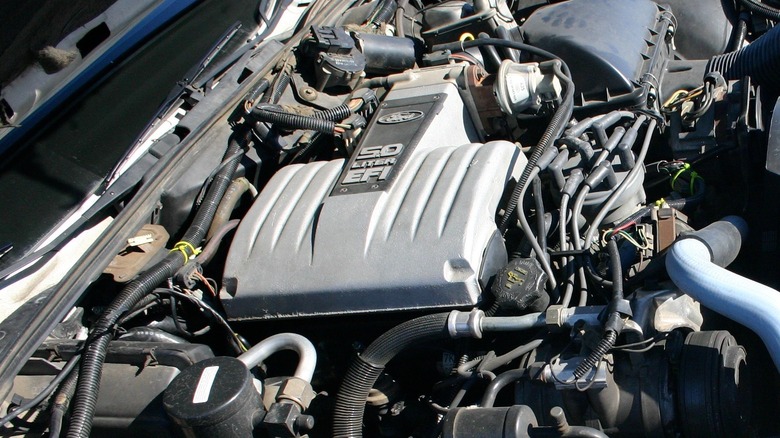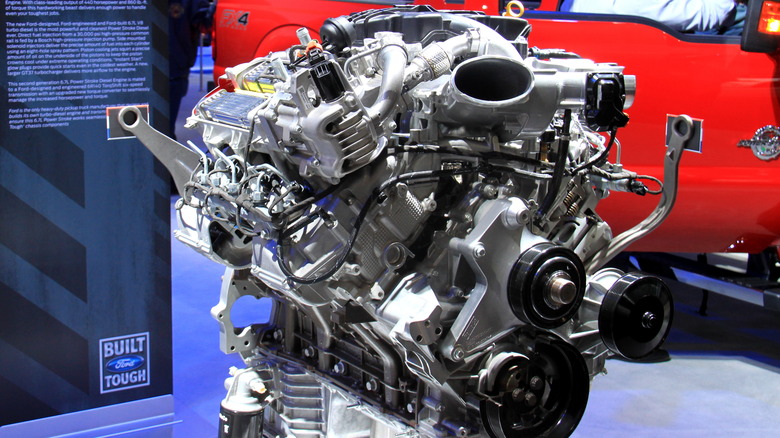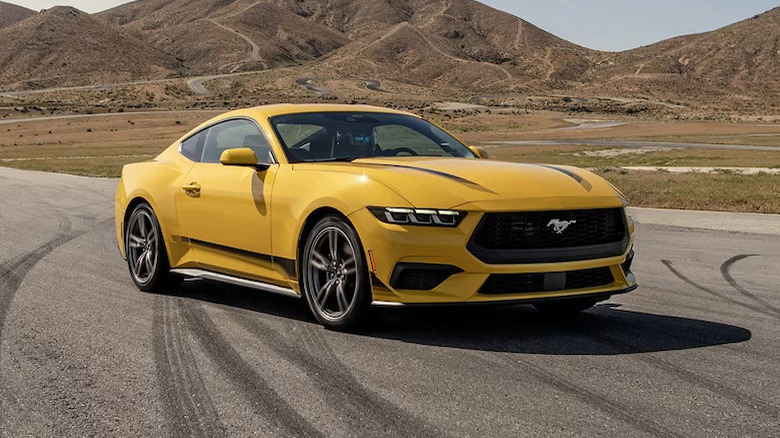6 Of The Most Reliable Engines Ever Made By Ford
No matter what kind of vehicle someone decides to buy, the hope is that it will last them quite a long time. For most people, cars and trucks are just too expensive to be throwing away cash whenever you please to constantly rotate out what is parked in their garage. So many things determine the lifespan of a vehicle, but one of the keys is its engine. After all, those hunks of metal that sit underneath the hood of your car are what makes it all run, and having an engine that you know you can count on through wear and tear could be the ultimate factor in determining whether or not you will be driving that car for two years or twelve.
For a car company like Ford, which has been around for well over 100 years, so many engines have been developed and produced by the American manufacturer that it can be a little difficult to parse through them all and find the ones that have built a reputation for their reliability. Sometimes, people get so caught up in what kind of power an engine can provide that they push aside the fact that the power may burn out the engine faster and cause problems.
With this piece, we are going to look at six different engines made by Ford over the years that have proved to be resilient. These might not be the true six most reliable engines, but based on reviews and specs of these engines from various sources, this list will give you a good idea of the variety of reliable Ford engines. A more in-depth explanation of our methodology will be provided at the end of the article.
5.0-liter Coyote V8
We start off this list with one of the most popular engines of Ford's modern era. Back in 2010, for the 2011 model year, Ford introduced the 5.0-liter Coyote V8 engine. This engine is part of Ford's Modular engine line and has routinely been ranked among the best engines on the market as it has evolved by institutions like Ward's AutoWorld. The Coyote engine has been used for a variety of vehicles that the automaker produces, from the Ford Mustang GT to the best-selling vehicle in the United States, the Ford F-150.
Part of the reason that this is considered one of the best V8 engines ever made is that it finds a very good balance between its power and efficiency, with its new fourth generation being able to reach up to 480 horsepower yet gets fairly decent mileage with 22 mpg in the city and 33 mpg on the highway when in a Mustang. Ford built the Coyote with twin independent variable camshaft timing, which is how it is still able to get decent fuel economy despite the tremendous amount of power it creates. Pair that with an engine built with high-quality material, and you will have a powerful V8 that will last you quite a long time. There's a reason Ford lets you put this engine in the most popular vehicle in the country.
[Featured image by Jpogi via Wikimedia Commons | Cropped and scaled | CC BY-SA 4.0]
Ford 300
We are going to turn back the clock a bit from the Coyote for the next Ford engine on this list, all the way back to 1965. Although production on this engine began nearly 60 years ago, it actually remained in production for three whole decades before being phased out. That engine is the Ford 300, which Slashgear has previously praised as one of the 10 most reliable six-cylinder engines ever.
Like any engine that started around that time, the Ford 300 experienced a decline in the mid-1970s with changes to emissions regulations and the oil crisis. However, by the end of its run in the mid-1990s, the Ford 300 was able to reclaim its place as a terrific engine, so much so that vehicles are still using it nearly three decades after it seized production.
The Ford 300 was first made for the company's F-Series pickup trucks but expanded beyond that as the years went on, such as the E-Series and the Ford Bronco. Part of the reason they are able to be so reliable is that they aren't incredibly powerful engines, standing as a counterpoint to the Coyote. At the end of its run, the inline-six engine could muster around 150 horsepower, and unless you are looking for some high-performance vehicle, you actually don't need a ton more than that. Keeping the power low allows the engine to withstand wear and tear a lot longer than most engines operating at a higher level. The Ford 300 is a no-frills workhorse that will last you a long time if it is f properly maintained.
[Featured image by Don don03 via Wikimedia Commons | Cropped and scaled | CC BY-SA 4.0]
Ford EcoBoost 3.5-liter Cyclone
The next engine we are going to cover brings us to the late 2000s. One of the lines of engines that Ford makes is its EcoBoost engine. These engines come in different varieties, including V-type, inline three-cylinder, and inline four-cylinder engines, and the goal of these engines — as the name implies — is to have an engine that is more fuel efficient and reduces greenhouse gas emissions while not sacrificing power to do so. For the 2010 model year, Ford introduced the 3.5-liter EcoBoost V6, a variation of the company's Cyclone engine that had been around for a couple of years.
Part of what makes this EcoBoost enticing is that it features both direct and port fuel injection, allowing for the best fuel efficiency depending on what speeds you are traveling at. Having both types of fuel injection also reduces buildup on the intake valves, which can cause problems for an engine if that buildup accumulates over time. They also generate a good deal of power, with the Ford F-150 being able to get 400 horsepower with this engine, and that number goes up to 430 horsepower with a F-150 Hybrid. Of course, these engines can be used across other vehicles as well, such as the Ford Expedition and even the Lincoln Navigator.
As was the case with the Ford 300, the 3.5-liter EcoBoost V6 Cyclone also ranked among Slashgear's most reliable six-cylinder engines, and that list encompasses all the companies and not just Ford. Naturally, it would have to make Ford's list as well.
Ford 5.0-liter EFI High Output
After the mid-1970s, V8 engines just weren't what they were in the heyday of the muscle car and the hot rod. Thanks to new emissions standards, these gigantic V8 monstrosities could never fully rebound, and the 1980s were not particularly kind to the engine. However, in 1986, Ford released its 5.0-liter EFI High Output engine, and it was a V8 that could satisfy those who desperately wanted power underneath the hood while remaining quite fuel-efficient in the process.
EFI stands for electronic fuel injection. Rather than having a carburetor for mixing your fuel with air, it is done with the aid of an engine control unit. Today, this is the norm for a vehicle's fuel injection system, but back in the 1980s, this was a pretty new phenomenon, especially in the United States. High Output, meanwhile, designates an engine that puts out more power than another engine of the same size. This was an engine that could generate up to 225 horsepower and 300 lb./ft. of torque and was used on everything from the Mustang to the Thunderbird to the Falcon.
The Ford 5.0-liter EFI H.O. did quite a lot to reinvigorate high-performance vehicles in the United States, so much so that parts for this engine remain some of the most sought-after parts for performance engines out there. This is even after engine manufacturing halted over two decades ago.
[Featured image by Sunstarfire via Wikimedia Commons | Cropped and scaled | CC BY-SA 3.0]
Ford 7.3-liter Power Stroke diesel V8
All of the engines mentioned above run on traditional gasoline, but not every engine works that way. Plus, they aren't the engines everyone is going to look at, particularly if they have a vehicle that is incredibly large and needs to run on diesel instead. When it comes to Ford, you don't need to look any further than its line of power stroke engines, particularly the very first one. That would be the 7.3-liter Power Stroke diesel V8, or more accurately, it is the Navistar T444E, as originally Ford did not actually manufacture the engine.
This was a massive diesel-powered V8 that was on the marketplace from the 1994-2003 model years, and though it was discontinued due to not meeting noise regulations, it is still probably the most reliable Power Stroke diesel Ford ever put in its vehicles. You might expect an engine as large as this to generate a bit more than 210 horsepower, but being a bit more level-headed in its output makes it an engine that can be somewhat more efficient and last longer. Ford made this engine available for the larger models in its popular F-Series of trucks along with its full-size E-series vans. This is an engine that first hit the market 30 years ago, and it's one that people are still putting in their Fords today.
[Featured image by RL GNZLZ via Wikimedia Commons | Cropped and scaled | CC BY-SA 2.0]
Ford 6.7-liter Power Stroke Diesel V8
While the 7.3-liter Power Stroke V8 may be at the top of the list, it is not made anymore, but that doesn't mean the entire Power Stroke line of diesel-powered V8 engines has come to an end. There is still the very reliable 6.7-liter Power Stroke V8 available for all your large-scale Ford needs. As this is a much newer engine that first hit the market for the 2011 model year, Ford has managed to pack in quite a lot more power into this engine, generating up to 475 horsepower and 1,050 lb./ft. of torque.
The first year or so models of this engine had some issues with turbocharger units and weak glow plugs, but those problems are now over a decade in the past. The 6.7-liter Power Stroke now is an incredibly sturdy engine that you can certainly rely on for your large truck or van. A big reason for this was increasing the number of bolts to hold down the engine's cylinders from four to six, leading to less of a chance of a blown gasket. This is now the largest Power Stroke Diesel V8 that Ford offers, and thankfully, you won't be disappointed if you need an engine this large and powerful.
[Featured image by Joseph Brent via Wikimedia Commons | Cropped and scaled | CC BY-SA 2.0]
Why these engines were chosen
Ford has made a cavalcade of engines over its century-long existence, so narrowing down the list of the company's most reliable to just six is no easy task. These are not meant to be the definitive six most reliable engines Ford produced, but they look to be an example of the various kinds of engines the company has made that have shown a high level of reliability over the years.
These engines were chosen after pouring through various reviews, reports, rankings, and retrospectives of many different Ford engines from publications, including Motor Biscuit, Motor Reviewer, Car and Driver, On All Cylinders, and SlashGear's own past writings on these engines. Once reliability ratings were taken into account, the decision was made to spotlight different sizes, types, and eras of engines to get a broader picture of the reliability Ford has offered over the decades.
